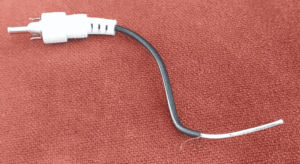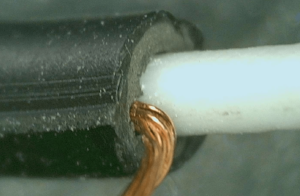
The implicit promise made by the maker of an RCA cable is that its center conductor is shielded by its outer conductor. I have, however, been astonished in recent times to see that many RCA cables are not shielded at all.
The point of an RCA connector is that it has a center pin conductor surrounded by a shell conductor. The RCA cable has RCA connectors at both ends. Each of the center pin conductors is connected to the other by a center conductor that runs the length of the cable. Each of the shell conductors is connected to the other by a second conductor. The cable that runs between the two RCA connectors is (supposed to be) a shielded cable. The point of shielded cable is that this second conductor surrounds (“shields”) the inner conductor. In this way, the inner conductor will hopefully pick up less EMI (electromagnetic interference) than it would if it were not shielded.
What got me started on this inquiry was a subwoofer that never turned itself off, even when it was supposed to turn itself off.
By way of background, these days a typical subwoofer is “powered” meaning that it has its own power amplifier, and for this reason the subwoofer needs to plug into an electrical receptacle. This means that the subwoofer output audio signal from the receiver does not need to be powerful enough to drive the speaker itself. The audio signal is a “line level” signal meaning roughly 1 volt peak-to-peak.
A typical subwoofer these days is “automatic”, meaning that an always-on circuit inside the housing of the subwoofer is constantly measuring the incoming signal level from the receiver. If the signal level remains below some threshold for an extended period of time, then the power amplifier gets switched off. Later if the incoming signal again rises above the threshold, the circuit turns the power amplifier on again. I’d guess the threshold in many subwoofers is around 15 mV.
If the subwoofer is physically very nearby to the receiver, then a single ordinary RCA cable works well for communicating the audio signal from the receiver to the subwoofer. If, on the other hand, the subwoofer and receiver are at quite some distance from each other, then a typical solution is to use one or more lengths of RG6 coaxial cable for most of the distance, and to use short RCA cables at each end of the RG6 cable, connecting to the subwoofer output at the receiver, and connecting to the receiver input at the subwoofer.
My problem was that nearly always, my subwoofer would remain “on” indefinitely, even after the receiver had been powered down. It became clear that some source of EMI was leaking into the audio path that feeds the subwoofer. The EMI was constantly triggering the “automatic” circuit by nearly always amounting to at least the threshold level (which, again, I estimate to be around 15 mV).
Eventually I found the culprits. There were three places along the audio path where I was using fairly short RCA cables as patch cables. (Most of the run is made up of several lengths of RG6 cable.) Each of the RCA cables turns out not to be shielded at all!
Before I cut into these RCA cables, I sort of assumed that what I would find is at least some half-hearted attempt by the cable manufacturer to surround the center conductor with the strands of the second conductor. This might have provided at least some shielding even if it was not completely successful shielding. What I absolutely did not expect to see is the strands of the second conductor running parallel to the center conductor.

At top right you can see the RCA connector and a length of the (supposedly) shielded cable, with a white inner conductor. At right is a close-up photo showing the inner conductors after the black outer jacket has been removed. As you can see, the white conductor is centered in the black jacket, as expected. But the second conductor does not surround the center conductor. The second conductor is merely an uninsulated stranded wire that runs parallel to the center conductor. It provides very little shielding function, if any.
Once I saw the lack of meaningful shielding in these RCA cables, I took them out of service (and I cut up two of them to make the photographs in this blog article). I then made my own new patch cables by cutting some pieces of RG6 cable to length, and soldering right-angle RCA plugs at each end. I replaced the poor quality RCA cables with these well-shielded cables. The presenting problem, namely EMI tricking the subwoofer into turning on when it should be off, went away.

Appreciate the technical sleuthing!
I had a computer monitor that kept blacking out for no apparent reason, until I noticed that it blacked out every time the refrigerator’s compressor kicked on. Same problem: a garbage “economy” cable from Amazon. Got a good one (VESA certified, which you do have to pay for), and problem solved.